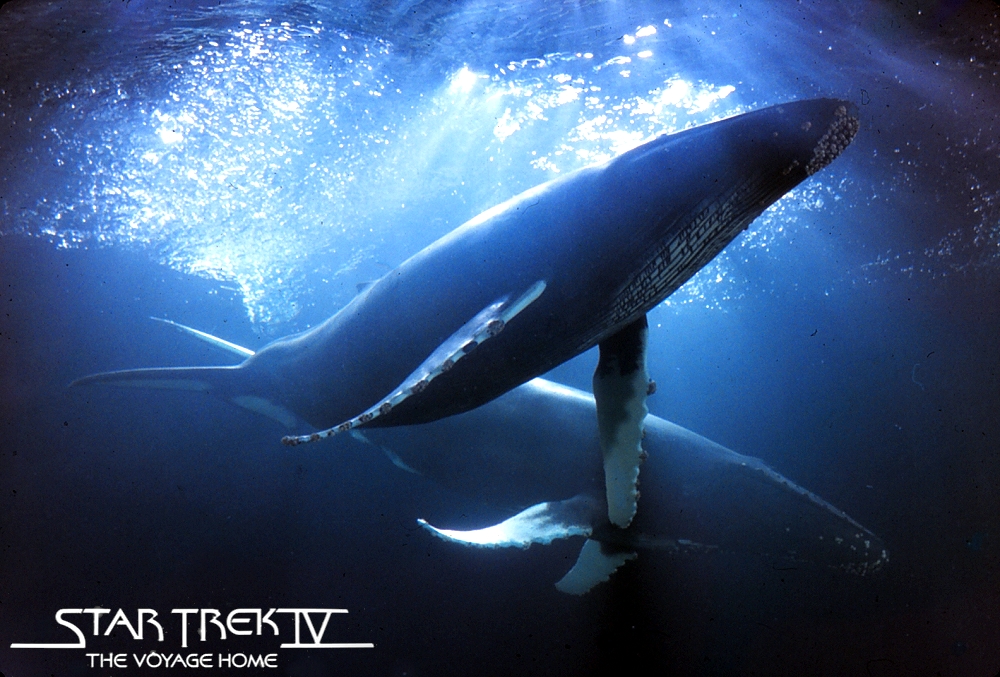|
Animatronic Whales |
|
|
|
|
|
The tricky whale effects on 'Star Trek IV: The Voyage Home' were handled by 'ILM' and their |
|
|
|
Tony Hudson and Tim Lawrence (ILM whale crew) produce a three-piece fiberglass mold from |

|
|
The masterpieces of Walt Conti, Gracie and George, in action in a swimming pool. Cameraman Pete Romano needs the help of several other divers to get the whales in the desired position. Each whale required 2 more technicians outside of the pool for the radio controlled motions of the tail and the fluke. The guys spent 2 weeks in the pool to get the underwater scenes of the whales. |

|
| Pete Romano in the pool with the two Humpback whale miniatures. |

|
| The stunning miniatures of Gracie and George. |

|
|
Project supervisor Walt Conti - Aquarium test for the miniature whales. There are difficulties involved here and there running electrical equipment underwater. It is nearly impossible to keep the inside of the minatures completely dry. If you try, the additional buoyancy may become a problem. And you have the risk of a total loss, if water finds its way. The crew decided just to keep the servos, batteries and the radio receiver dry and let everything else get flooded. |

|
|
Dry-for-wet test of a whale bursting out of the water, a thin membrane covered with icing sugar. The miniature whale was shot through the membrane by a spring-loaded catapult. Of course they didn't shot an expensive radio controlled miniature to the moon. A cast of the original minature was used for this stunt. |

|
|
A full-size whale section of the fluke in the dust-dry Paramount water tank (parking lot). The mechanical fluke was about twelve feet wide and eighteen feet long. |

|
|
The fluke was rigged on a dolly on a track and pulled through the shot by air motors. There were two small humps in the track to get the shots of the fluke coming up and diving back down underwater. The hydraulics were controlled via joysticks. One hydraulic set (cylinders) pumped the whale the other moved the fluke. |

|
|
The crash landing of the 'Bird of Prey' under the Golden Gate Bridge was done in miniature in a small pool built on the 'ILM' parking lot. The Golden Gate Bridge was a wood replica made for a special perspective and camera vista. The 'Bird of Prey' miniature was on a wire rig for the flight under the bridge and the crash. All photographed under stormy conditions (heavy smoke fogger, wind machines, water blasters) to obscure the painted backdrop. Parts were shot by using a bluescreen. The complicated low-angle shot was photographed by Don Dow. |

|
|
Now we are back in the Paramount pool. Physical effects supervisor Michael Lantieri was in charge for the full-scale storm effects with the crew and the full-size whale sections being involved. Heavy wind machines, big wave machines and all you need for a tough storm was running on hurricane level in this scenes. The actors had to hold on pretty tight to the mockup, otherwise they would have been blown away. |

|
| A last salute out of the Paramout pool. |

|
|
The 'Star Trek IV: The Voyage Home' cast and crew at the Paramount pool. Standing in the middle Star Trek mastermind Gene Roddenberry. |
|
|

|
|
If you want to learn more about Walt Conti, I recommend his website:
Walt Conti His ingenious 'Anaconda' (photo) is a true animatronic masterpiece. |

